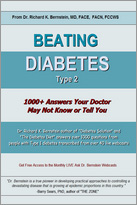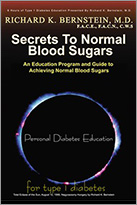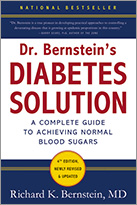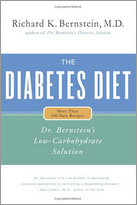Research into creating replacement cells for burned-out insulin producing
pancreatic beta cells is so promising that it’s tempting to think of a “cure” not in terms of if but when. The reality is, however, less rosy. There may one day be a cure, but to put off normalizing your blood sugars until then is simply to ignore the reality of your situation. If you’re going to control your diabetes and get on with a normal life, you will have to change your diet, and the when is now. No matter how mild or severe your diabetes, the key aspect of all treatment plans for normalizing blood sugars and preventing or reversing complications of diabetes is diet. In the terms of the Laws of Small Numbers, the single largest “input” you can control is what you eat.
THE FUNDAMENTAL IMPORTANCE OF A RESTRICTED-CARBOHYDRATE DIET
The next several pages may well be the most difficult pages of this book for you to accept—as well as some of the most important. They’re full of the foods you’re going to have to restrict or eliminate from your diet if you’re going to normalize your blood sugars. You may see some of your favorite foods on our No-No list, but before you stop reading, keep in mind a few important things. First, toward the end of this chapter we discuss the foods you can safely eat. Second, while you will have to eliminate certain foods, there are some genuinely sugar-free and low-carbohydrate alternatives.
One purpose of blood glucose self-monitoring is to learn through your blood sugar profiles how particular foods affect you. Blood sugar self-monitoring is the ultimate measure of the effect foods have on your blood sugar. If you don’t believe what you’re reading here, check your blood sugars every 2 hours after consuming food you are certain must be benign. Over years of examining profiles like the ones you will create, I’ve observed that some people are more tolerant of certain foods than other people. For example, bread makes my own blood sugar rise very rapidly. Yet some of my patients eat a sandwich of thin bread every day with only minor problems. Inevitably I find this is related to delayed stomach-emptying (see Chapter 22). In any case, you should feel free to experiment with food and then perform blood sugar readings. It’s likely that for many diabetics most or all of our restrictions will be necessary.
Patients often ask, “Can’t I just take my medication and eat whatever I want?” It almost seems logical, and would be fine if it worked. But just taking your medication and eating whatever you want doesn’t work — because of the Laws of Small Numbers—so we have to find something that does.
Many diabetics can be treated with diet alone, and if your disease is relatively mild, you could easily fall into this category. Some patients who have been using insulin or oral agents find that once on our diet they no longer need blood sugar–lowering medication. Even if you require insulin or other agents, diet will still constitute the most essential part of your treatment.
Think small inputs. You may recall from prior chapters that—for even the mildest diabetic—the impairment or loss of phase I insulin response makes normalizing blood sugars impossible for at least a few hours after a high-carbohydrate meal. Eating even small amounts of fast-acting carbohydrate raises blood sugar so rapidly that any remaining phase II insulin response cannot promptly compensate. This is true if you’re injecting insulin or if you’re still making your own insulin. Any sensible meal plan for normalizing blood sugar takes this into account and follows these basic rules:
• First, eliminate all foods that contain simple sugars. As you should know by now—but it bears repeating—“simple sugar” does not mean just table sugar; that’s why I prefer to call them fast-acting carbohydrates. Most breads and other starchy foods, such as potatoes and grains, become glucose so rapidly that they can cause serious postprandial increases in blood sugar.
• Second, limit your total carbohydrate intake to an amount that will work with your injected insulin or your body’s remaining phase II insulin response, if any. In this way, you avoid a postprandial blood sugar increase, and avoid overworking any remaining insulin-producing beta cells of your pancreas (research has demonstrated that beta cell burnout can be slowed or halted by normalizing blood sugars).
• Third, stop eating when you no longer feel hungry, not when you’re stuffed. There’s no reason for you to leave the table hungry, but there’s also no reason to be gluttonous. Remember the Chinese restaurant effect (page 95).
TESTING FOR STARCH OR SUCROSE IN FOODS
Sometimes you’ll find yourself at a restaurant, hotel, or reception where you cannot predict if foods have sugar or flour in them. Your waiter probably has little idea of what’s in a given recipe, so don’t even ask him; his response will likely be incorrect. I’ve found that the easiest way to make certain is to use the Clinistix or Diastix that should have been checked off on your supply list (Chapter 3). These are manufactured to test urine for glucose.We use them to test food. If, for example, you want to determine if a soup or salad dressing contains table sugar (sucrose) or a sauce contains flour, just put a small amount in your mouth and mix it with your saliva. Then spit a tiny bit onto a test strip. Any color change indicates the presence of sugar or starch. Saliva is essential to this reaction because it contains an enzyme that releases glucose from sucrose (table sugar) or from flour in the food, permitting it to react with the chemicals in the test strip. This is how I found that one restaurant in my neighborhood uses large amounts of sugar in its bouillon while another restaurant uses none.
Solid foods can also be tested this way, but you must chew them first. The lightest color on the color chart label of the test strip container indicates a very low concentration of glucose. Any color paler than this may be acceptable for foods consumed in small amounts. The Clinistix/Diastix method works on nearly all the foods on our No-No list except milk products, which contain lactose. It will also not
react with fructose (fruit sugar; also present in some vegetables and in honey). If in doubt, assume the worst.




